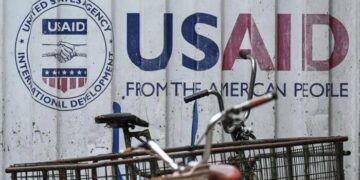By Michael Every of Rabobank
As the whirlwind of the US political, geopolitical, and geoeconomic (counter?) revolution plays out, it’s getting harder for even the most committed bean counter and econometricians to ignore.
Secretary of State Rubio will not be attending the upcoming G20 in South Africa to protest its policies. It remains to be seen if the G20 now joins the growing list of acronymic institutions that the US no longer has time for. If the latter, how long until we get to the holy of holies, the IMF? After all, is there any US strategic logic in supporting a multilateral institution whose neoliberal economic policies have been largely opposed to its own for the last eight years, and which will be even more counter to its stance for the next four?
The prospect of the US ‘owning’ Gaza has been floated, then sunk by all other parties, yet the US says this a starting point for new thinking, challenging others to come up with ideas that must, by design, shake things up. There’s not any oil involved here, but the key Suez Canal is very close, and the ‘if lines on maps can move —and peoples— so can lines on screens’ and “This is America too” elements are worth noting for those who think about volatility and term premia.
President Trump is also again talking about a deal with Iran if it will drop its potentially accelerated efforts to build a nuclear bomb and work with the US. So far, the track record in flipping members of the Axis of Resistance to Team Trump is poor, and the threat of being “smashed to smithereens” is still out there, even if markets once again jumped on the ‘Trump is all about the deal, not dealing with things’ bandwagon.
Panama now allows the US Navy to use its Canal for free, may cancel the contracts of the Hong Kong firm operating the ports of Balboa and Cristobal at either end, and has agreed to “safeguard the canal” and “increase military collaboration” with the US. Guess which of the two will be sending more collaborating forces to the other? Defence Secretary Hegseth also stressed the US commitment to its mutual defence pact with the Philippines and offered increased defence aid to it – which will not please China.
Major US tech firms with one foot in the US and the other in China seem on the shakiest of ground; that’s as the US postal service has reinstated parcel service from China and Hong Kong after briefly suspending it, a warning to those assuming goods must flow.
Of course, there are also tariffs, which bean counters and econometricians understand ‘best’. As one headline has it, ‘Chicago Fed’s Goolsbee Shifts From Dove To Hawk, Says Tariffs Impact On Inflation ‘Might Be Much Larger This Time’’
Meanwhile, Treasury Secretary Bessent says US tariffs will be back (not just vs Canada, Mexico, and China): the long game globally is “to squeeze trading partners now to create a self-sufficient industrial base later.” ‘Goolsbees’ will have to get buzzy with that in their modelling from now on, as will market observers bravely saying, “Trump is a trade paper tiger.” Indeed, India is already sending out signals that it is not a “tariff king”, happy to yield that metaphorical crown in the hope of some upcoming noblesse oblige on trade from the White House – an outcome which may depend on geopolitics as much as comparative advantage.
Bessent then ‘clarified’ that President Trump is not leaning on the Fed to lower rates – he would just like to see them lowered. See the difference? More importantly, the key focus is not Fed Funds but the US 10-year yield. So, Treasury ‘focus’, not an official target. See the difference?
Notably, Bessent thinks 10-year yields can decline as a result of his “3, 3, 3” economic policy targets – 3% real GDP growth, a 3% fiscal deficit, and a 3m barrels per day (bpd) increase in oil production. Yet they are not going to be possible without economic statecraft. To join the dots for you here:
- A 3% fiscal deficit might see some inroads made by DOGE’s ferreting efforts and the 1% voluntary shrinkage in the federal civil service already achieved, but with permanent tax cuts also lobbied for by Bessent –and a 15% corporate tax rate by the president– it would need a lot of new revenue from tariffs, which he also floated;
- A 3% rate of real GDP growth needs help from the Fed and the long end of the curve, which won’t do so voluntarily while they worry about tariff inflation;
- The 3m bpd US oil equivalent increase won’t happen via market forces, even if Energy Secretary Wright just announced “Net-zero policies raise energy costs for American families and businesses, threaten the reliability of our energy system, and undermine our energy and national security… the Department’s goal will be to unleash the great abundance of American energy required to power modern life and to achieve a durable state of American energy dominance.“ While our energy analyst Joe DeLaura expects oil prices to drift lower, to get cheap oil the US may have to use the Defence Production Act to force firms to “Drill, baby, drill”; or subsidies – paid for by tariffs(?); or get help from Venezuela –not in the US camp– or Iran –under “maximum pressure”– or Saudi Arabia, who at current oil prices already can’t afford their megaprojects like the first (and last?) linear city, Neom.
One perhaps starts to see how the Middle East, and the Americas and the US Monroe Doctrine, and White House economic, political, and even military statecraft are all in the complex mix here. Or perhaps once doesn’t and just counts beans. But it’s all going to play out anyway.
On which note, gold continues to flood out of the Bank of England’s vaults, as the French government survived a no-confidence vote, avoiding chaos. Europe plans more customs checks and fees to stem the flood of low-value parcels from China. This time it’s only acting a few days behind the US on economic statecraft rather than the customary few years; however, the headline that ‘We need a Draghi report for banking, say EU’s three biggest countries’ underlines that in key respects Europe is centuries behind the US, which doesn’t help with its statecraft, and hence its economic policy targets or competitiveness compasses, in any shape or form.
Elsewhere, the BOJ’s Tamura today, the bank’s most hawkish member, suggested there could be two or more 25bps rate hikes in the fiscal year starting in April, and that the BOJ’s key rate should be back at 1% by H2 2025. Obviously, this pushed JPY higher.
It will be interesting to see if/how Washington, D.C. and Tokyo, and the BOJ and the Fed, can coordinate not just their monetary policies but their statecraft together going forwards. Markets will need to know the same if even they don’t focus on that bigger picture.
The same is of course also true for D.C. and London and Mexico City, and the Fed and the BOE and the Bank of Mexico, both of which meet on rates today.
There are lots of uncomfortable thoughts in all this for some: but I am just Bessent-ing the facts of life.
Loading…
Read the full article here







